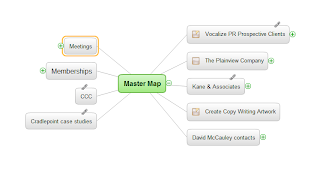
I had the pleasure of interviewing Amanda Larrinaga, a really good marketer from Boise who, sadly, has moved to Montana. Not only is she good at what she does (especially in terms of helping companies do social media using advanced visual aesthetics), but she devotes a lot of time and energy to staying current with and embracing new technology.
Before I get into Amanda's comments on how she uses MINDMAP, here's her map (made for a photographer here in Boise):
If You Don't Think Like Other People, Rejoice...But Find a Common Language
Amanda talks about the struggle some creative people have of taking what's in their heads and making it understandable to others.
“When I’m planning a project—whether it’s for my own business or for a client—there are always lots of moving pieces and parts, I need to communicate a lot of detail. But I have to do it in a way that won’t overwhelm people.”
Part of the reason it doesn't overwhelm people, she says, is that you can control what the staff member or client sees:
“It’s so easy for people to get overwhelmed with information. MINDMAP allows you to show it to them one piece at a time—moving on only when you’re sure they understand the piece before them.”
Clients Got Attention Deficit Disorder?
And I liked her description of how MINDMAP can help you manage clients--many of whom seem to have ADD when it comes to following along with a presentation:
“Sometimes we’ll be talking about one aspect of a marketing plan when the client suddenly starts to fixate on something else. The map structure lets me jump instantly to that part of the plan they want to discuss. Sometimes they just want to make sure we’ve dealt with something that has just popped into their heads."
"I could assure them with words that we’re going to talk about, say, pamphlets. But it’s much more assuring if I can open up the part of the map that talks about brochures and let them see for themselves.”
And she says that when she does jump to another part, it’s very easy for her to change content on the fly to reflect changes in she and/or the client’s thinking.
Tired of Pulling Teeth?
...now that I use mind maps, I never have to push for questions. I get them right away.
One thing she mentioned really struck home for me because I've seen it so many times:
“Even if I’m really probing for questions and trying to really create a conversation, it can just be really frustrating. And as a business owner, it can be a little stressful when the client seems to have nothing to say—because I know they’re usually stewing about something. But now that I use mind maps, I never have to push for questions. I get them right away.”
I remember interviewing someone at Hewlett Packard who told me how, when she used mind mapping with people from another country who were not native English speakers, the rates of participation were always high.
Words of Wisdom from a Self-Confessed TechnoGeek
But probably the coolest thing Amanda said comes from the fact that one of the things she's passionate about is helping her clients find tools that are easy to learn and help them do what they do.
“A big part of my business is making recommendations around implementing different technologies or processes. I pay attention to user friendliness and how intuitive something is. I’ve found that while there is always a range of people’s skill sets, ConceptDraw MINDMAP is one tool that I always recommend, no matter someone’s background.”
Thanks, Amanda!











